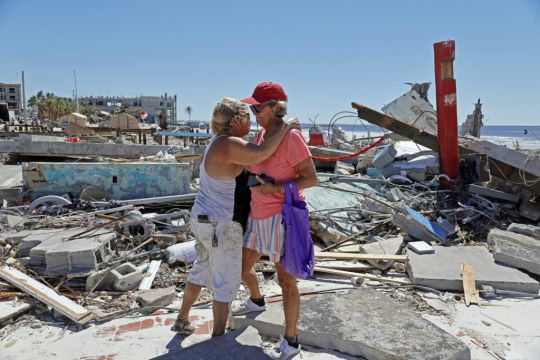Rescuers are searching for survivors among the ruins of Florida’s flooded homes while authorities in South Carolina began assessing the damage as the remnants of Hurricane Ian, one of the strongest and costliest hurricanes to ever hit the US, continue to push north.
The powerful storm terrorised millions of people for most of the week, battering western Cuba before raking across Florida from the warm waters of the Gulf of Mexico to the Atlantic Ocean, where it mustered enough strength for a final assault on South Carolina.
Now weakened to a post-tropical cyclone, Ian is expected to move across central North Carolina on Saturday before moving into Virginia and New York.
Hurricane dangers remain ever after the skies turn blue. Watch out for downed power lines and damaged buildings. Avoid floodwaters as they can hide a variety of dangers, and never drive through them, as it doesn’t take much to sweep your car away.https://t.co/e8saA4ZGIX pic.twitter.com/WQDCPE1aOj
— National Weather Service (@NWS) October 1, 2022
Advertisement
At least 30 people were confirmed dead, including 27 people in Florida – mostly from drowning, but others from the storm’s tragic after-effects.
An elderly couple died after their oxygen machines shut off when they lost power, authorities said.
Meanwhile, distraught residents waded through knee-high water on Friday, salvaging what possessions they could from their flooded homes and loading them onto rafts and canoes.

In South Carolina, Ian’s centre came ashore near Georgetown, a small community along the Winyah Bay about 60 miles north of historic Charleston.
The storm washed away parts of four piers along the coast, including two connected to the popular tourist town of Myrtle Beach.
The storm’s winds were much weaker on Friday than during Ian’s landfall on Florida’s Gulf Coast earlier in the week.
Authorities and volunteers there are still assessing the damage as shocked residents tried to make sense of what they just lived through.

Pawleys Island, a beach community about 73 miles up South Carolina’s coast from Charleston, was among the places hardest hit by Ian.
Bridges on Pawleys Island were strewn with palm fronds, pine needles and even a kayak retrieved from a nearby shoreline. An intercoastal waterway was littered with the remnants of several boat houses torn apart and knocked off their pilings in the storm.
Even though Ian has long passed over Florida, new problems continue to arise. A 14-mile stretch of the Interstate 75 road was closed late on Friday in both directions in the Port Charlotte area because of the massive mount of water swelling the Myakka River.
Ross Giarratana, a meteorologist at the National Weather Service in Tampa, said the Myakka was cresting at a record 12.73ft on Saturday morning.

Further south-east, the Peace River was also at a major flood stage early on Saturday in the Polk, Hardee and DeSoto counties. The majority of those points have not yet crested, Mr Giarratana said.
“It was crazy to look at just how quickly the rivers were rising,” he said. “We knew that we were in for some record stuff.”
The official death toll climbed throughout the day on Friday, with authorities warning it would likely rise much higher once crews made a more comprehensive sweep of the damage.
Hurricane Ian has likely caused “well over 100 billion dollars (£80 billion)” in damage, including 63 billion dollars (£56 billion) in privately insured losses, according to the disaster modelling firm Karen Clark and Co.
If those numbers are borne out, that would make Ian at least the fourth-costliest hurricane in US history.







